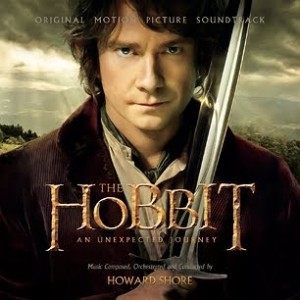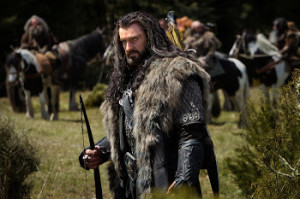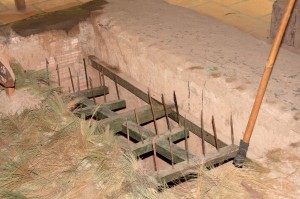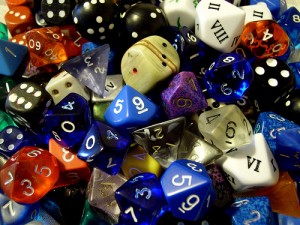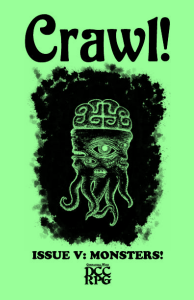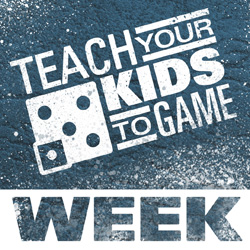 The Iron Tavern recently interviewed Quinn Conklin, one of the driving forces behind the Toys for the Sandbox series from Occult Moon. In addition to writing the weekly fantasy series he also has a role in the post-apocalyptic and science fiction flavors of Toys for the Sandbox as well.
The Iron Tavern recently interviewed Quinn Conklin, one of the driving forces behind the Toys for the Sandbox series from Occult Moon. In addition to writing the weekly fantasy series he also has a role in the post-apocalyptic and science fiction flavors of Toys for the Sandbox as well.
Because keeping a weekly series churning out is not enough to keep the man busy, he also has taken up writing some adventures for new to the scene, BareBones Fantasy, a rules-light fantasy RPG from DwD Studios.
Quinn also has a couple of side projects that he picks up as time permits. Between all of this he still manages to squeeze in some time for gaming!
And with that, let the interview begin!
________________________________________________
The first thing that comes to my mind when I hear the name Quinn Conklin is the Toys for the Sandbox weekly series you write for Occult Moon. Can you tell us a little more about that series?
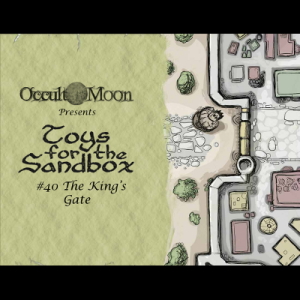 The core of the series is a simple idea. Develop a location that a GM can drop into their game when they need to add a bit of color. But a setting is just a place to make it come alive it needs history,people and a bit of bustle. So each issue of Toys has a bit of flavor text covering the history of the place and what it looks like, four NPCs that could be encountered there, six plot hooks with three twists each to serve as a launchpad for an adventure and a few (usually magic) items that the party might find there as well.
The core of the series is a simple idea. Develop a location that a GM can drop into their game when they need to add a bit of color. But a setting is just a place to make it come alive it needs history,people and a bit of bustle. So each issue of Toys has a bit of flavor text covering the history of the place and what it looks like, four NPCs that could be encountered there, six plot hooks with three twists each to serve as a launchpad for an adventure and a few (usually magic) items that the party might find there as well.
For readers unfamiliar with the Toys for the Sandbox series, are they written with a specific system in mind or are they system neutral?
They are system neutral which presents its own set of challenges, I can’t describe a magic sword as +5 I have to use phrases such as gives a significant bonus to damage.
Which issue is your favorite in the series so far? What makes it stand out for you?
That is a hard question, when I am writing one I am very excited about it, but that fades as I move on to the next. A few do stand out, The Dormant Volcano comes to mind mainly for the character of Jeremy, a young man who drank from a cursed pool and is now stuck in the body of a flying squirrel while the squirrel is running around in his body. The Weeping Widow has a lot of plot lines started that have spread out to other issues, and the recent arc I have been working on, The City by the Sea, has been fun as well and has let me explore some issue about race and politics.
You have a print version of the first 18 issues of Toys for the Sandbox coming up. How has that been coming together? Do you have an anticipated release date for this print version?
Honestly it has been slow. The series has gone through a lot of growth since it started back in January. We started with a four page product and now are up to around 13. Some of that came from great NPC descriptions and back story and that meant going back and updating some of the old text so each would have a standard feel. Also when I started writing Toys and was trying to keep things to the four pages I tended to have ideas that did not fit so they wound up posted on the Occult Moon website. In doing the print edition we decided to make room for those posts as well.
As to release date, I have the proof in hand now and so does my editor, we have come across a few last minute changes that need making and then we will be putting it up for sale. My hope is that we can have it go live on the 26th.
There are two spin-offs of the Toys for the Sandbox series that cover the sci-fi and apocalypse genres. Those are a little earlier in their lifecycle. What has been your role in those lines?
 These two series have always been planned as a limited run project. The target was 10 issues of each but as usually happens we had more to say then we thought and the Post Apocalypse Toys line wound up going to 11. Sci Fi is still going on and publishing monthly rather than weekly. I have not been that active in Sci Fi Toys line other than creating the flavor text, character, and hook format. With PA Toys I co-wrote it with Gary Montgomery and did the design and layout.
These two series have always been planned as a limited run project. The target was 10 issues of each but as usually happens we had more to say then we thought and the Post Apocalypse Toys line wound up going to 11. Sci Fi is still going on and publishing monthly rather than weekly. I have not been that active in Sci Fi Toys line other than creating the flavor text, character, and hook format. With PA Toys I co-wrote it with Gary Montgomery and did the design and layout.
The publication schedule you adhere to for these series is what many would consider quite aggressive. Between writing the product, getting it through layout, and published for sale, how do you keep up?
The key for me is having a process. Monday after the new issue goes on sale I know it is time to start working on the next issue, I need to have the flavor text and characters done by Tuesday night so I can send them off to my artists so they have time to work. That keeps the momentum going and the rest of it just flows.
By now the layout is not that hard to get through, I have a template I work from and it is really just a matter of plugging the pieces in.
Do you have issues already written and in the queue? Or is the issue you work on this week the one you will be publishing on Monday of the following week?
I would love to try and have issues in the queue and I have managed to make it happen a few times but it never lasts. One of my first paid writing gigs was working for Patch.com writing daily news. So coming out of an environment where I would get a call at 7 a.m. saying there was a protest going on at such and such a place and having the story in by noon, a weekly schedule is not that insane.
In addition to writing volume you also have the pressure to come up with a new idea every week. How do you come up with that many workable ideas and turn it into a product week after week?
Again I do it by having a plan in place. I try to alternate issues between wilderness and city locations for starters. The other thing I do is set up large locations and explore them, The Hermits Island, The Pirate Island and now the City by the Sea are good examples. When I have these series within the series going I don’t want to beat people over the head with them so I usually work on those every other issue or every three depending on the scope of the place.
But sometimes ideas are hard to come buy, if I really hit a snag i will take requests on G+ for things that people want to see, The Hamlet Under the Waterfall and the Wandering Wells of Mistomore are issues that started that way.
Other times it is just a matter of asking the world around me the right question. Issue 49 The Salt Mine is a good example of that. I was sitting down to brunch with my character artist, it was Tuesday morning and I had no idea what I was going to write about still. I looked at the table and started thinking about the condiments and asking them where they were going to take me today. We are probably lucky the salt shaker answered before the hot sauce.
Tell us a little about your gaming background. What were the first games you played?
I started off on AD&D and the original Red Box in the early 80’s or perhaps the late 70’s, it was 3rd or 4th grade. Champions, Gamma World and Star Frontiers were other games I had early but did not play much. FASERIP Marvel was the game we played through half of high school then we moved our supers world to the Palladium system.
What games are on your current playlist?
The big ones for me at the moment are Dungeon World, BareBones Fantasy, and Fate Core. My home group has really loved the Dresden Files but then people moved and syncing schedules got rough. The writing schedule does not give me as much time to play as I like.
We’ve talked about Toys for the Sandbox and associated projects. As we begin to turn the corner to a new year, what else do you have in store for us?
A few other things on the Toys front, we are planing to get the rest of this year’s back issues collected in two more omnibuses in the first quarter of 2013. After that the PA toys line will get its own collection and when the first run of Sci Fi toys is done it gets an omnibus. Also year two of toys will be rolling out at the same breakneck pace.
I have a few irons in the fire and it will be interesting to see where they go, I have been working on a pair of systems that I hope to have ready for release in the next year. One is a story game called Agents and Champions that is more in the vain of DO or Fiasco but crunchier than both. The other is my own fantasy RPG called Whack Pack Adventures, that one started to see a lot of feature bloat and I needed to walk away for a bit.
I am also working with DwD Studios and writing adventures for BareBones Fantasy.
Can you tell us a little more about Whack Pack Adventures?
WPA is sort of my answer to the OSR scene but rather than trying to create a game that models the rulesets I loved in high school I am working on something that models the feel of those games. We, and by we I mean my gaming group when I was growing up, would play these pick up games that we just called Whack Pack. It had an anything goes mentality with people playing monsters and the dice falling where they may.
It is hard to say more without getting into specifics of the game you know 20 races, separation of race and culture in character creation, spell customization, every things is combat, blah blah blah…
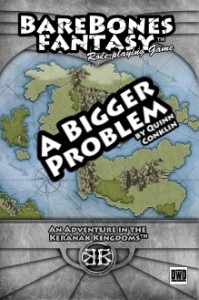 BareBones Fantasy from DwD Studios has been on my radar. You wrote A Bigger Problem for them, right? Tell us a little more about writing adventures for the BareBones Fantasy system.
BareBones Fantasy from DwD Studios has been on my radar. You wrote A Bigger Problem for them, right? Tell us a little more about writing adventures for the BareBones Fantasy system.
Yep I wrote A Bigger Problem and the follow up The Children of the Giants Fist. Currently I am working on the last part of that story arc.
Writing adventures is weird for me because I am the guy who never ran a module, well almost never. I tried to run one canned adventure for Brave New Worlds and wound up literally throwing the thing over my shoulder as the party saw a solution that was logical and so far off the rails of the printed material that it was useless to me at that point.
This is something that I have kept in mind as I have been writing for BBF. Make the players choice count for something, though that might not be obvious in the first two installments since those are about the players reacting to problems in town but even then there are opportunities for real choices by the players.
The system is easy to write for but does not feel too simple. A lot of rules light games, at least for me do not offer much in the way of room for characters to grow, that is not something I feel with BBF. The world feels big and the people in it feel real and the system has let me write some complex skill challenges that are more interesting than pass or fall to your death.
The guys over at DwD are great to work with as well. Larry Moore is always encouraging me to expand their world, add monsters and magic and all that good stuff. And Bill Logan is good about asking the right questions to put the polish on things.
_______________________________________________________
The Iron Tavern wants to thank Quinn for taking the time to answer my questions. It was a pleasure interviewing him!
 Decahedron is the first issue of its free fanzine from DwD Studios. The inaugural issue supports their recent RPG release BareBones Fantasy, a rules-light fantasy genre roleplaying game. Haven’t heard of BareBones Fantasy yet? Don’t worry, we will be taking a closer look at that system in an upcoming post at The Iron Tavern.
Decahedron is the first issue of its free fanzine from DwD Studios. The inaugural issue supports their recent RPG release BareBones Fantasy, a rules-light fantasy genre roleplaying game. Haven’t heard of BareBones Fantasy yet? Don’t worry, we will be taking a closer look at that system in an upcoming post at The Iron Tavern.




